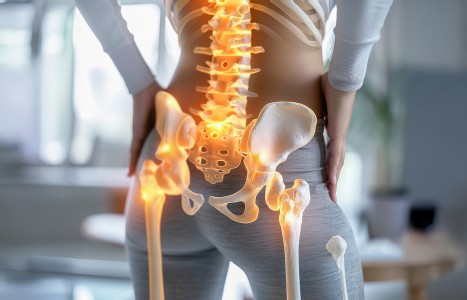Because they have yet to pass national legislation protecting the chiropractic profession, Japanese DCs are in a similar situation that U.S. DCs faced. We were fortunate enough to be able to pass chiropractic licensure state by state. The DCs in Japan must accomplish this nationally, which has proved to be an extremely difficult task. And in spite of their efforts, Japanese DCs are currently faced with two chiropractic professions.
Anti-Aging and Osteoporosis
I live next door to South Coast Farms (SCF), which is located in the city of San Juan Capistrano. I always get a kick out of organic farming, and visits to SCF provide me with a hint of nostalgia, considering I grew up in Kasilof, Alaska on the Kenai Peninsula. It is a little-known fact that glacier silt is rich in minerals. I have always felt that this is the reason our summer garden possessed heads of lettuce that easily reached the size of pumpkins! (That and the many hours of summer sunlight allowing for photosynthesis.) Every Alaskan neighbor is well-versed in organic herbal and produce farming on the Kenai. I suppose that everyone here in Southern California is fascinated by my neighbor Farmer George and the SCF dedication to the challenges of organic farming in this unique urban setting. SCF grows more than 40 varieties of organic fruits and vegetables, which are rich in vitamins and minerals. (SCF vegetables also are rich in calcium and magnesium.)
So, what does all that have to do with osteoporosis or anti-aging? As a doctor of chiropractic, I certainly want to prevent degeneration diseases such as osteoporosis in my patients. I also want my patients to live rich and vibrant lives; they can't do that plagued with spontaneous bone fractures, curvature of the spine and severe backaches. While osteoporosis usually strikes later in life, research suggests that the seeds for this debilitating disorder may be planted much earlier. Much compelling evidence suggests that a lack of calcium intake during adolescence (when many girls begin dieting) may compromise the development of peak bone mass, which could lead to osteoporosis later in life.
I recall one patient of mine, who was brought in by her father; an adolescent teen, with sway back presentation. Nancy certainly had curvature of the spine on X-ray evaluation, was overweight, and had acne. Every session for her curvature condition included a lot of education on diet, since her spine was still developing. I encouraged her with exercises for muscle balancing (weight-bearing exercises aid bone mass) and the importance of avoiding a diet high in refined foods, soft drinks and high amounts of protein, which all increase calcium loss and increase her risk for osteoporosis later in life. High-protein diets increase ammonia production in the gut, which prevents the kidneys from reabsorbing the calcium, thus increasing the urinary excretion of calcium. But it wasn't until I told her to not consume any more soft drinks that she finally got it and began to lose weight and to take a genuine interest. I first had to explain what minerals were, and that the blood maintains equal levels of both calcium and phosphorus. I also had to explain that if soft drinks, which are high in phosphorus, are ingested, the body will leech calcium from the bones to maintain balanced levels of calcium and phosphorous in the blood. Nancy didn't want her spine stuck in that position. I actually taught this adolescent girl how food works.
I stated earlier that osteoporosis (like so many diseases) is a degeneration disease or deterioration - changing from a higher to lower form, especially a change of tissue to a lower or less functionally active form. Bone is a living tissue. Osteoporosis is characterized by quantitatively low bone mass, but the composition of the remaining bone is normal. Osteoporosis is considered a progressive decrease in bone density, which develops when bone breaks down faster than it can be rebuilt. Bone cells that build new bones are called osteoblasts; bone cells that break down bone are called osteoclasts.
To test this function in my patients, I order Bone Density N-Telopeptides, or NTx [osteoporosis urine screen]. This is a simple laboratory test you can obtain for your patients. (If you practice in California, try Quest Diagnostics). The clinical uses for this test are to predict future bone mineral density (BMD), to monitor patients with metabolic bones disorders, and to detect bone metastasis in patients with various malignancies. Healthy levels of BMD are maintained by a balance between bone resorption and bone formation. NTx, the amino terminal cross-linked peptide of Type I collagen, is released during bone resorption. NTx-increased results in urine indicate an increased rate of bone resorption. Such increases may be observed not only in osteoporosis, but also osteopenia, rheumatoid arthritis and growth hormone deficiency.
Multiple studies have demonstrated NTx is an early marker or predictor of BMD response.1,2 Therapeutic response can be determined within 3-6 months of therapy instead of waiting a year or more.3 For example, in those women requiring bioidentical hormone replacement, the NTx test is a good indicator of therapeutic response.4 While estrogen has some control over osteoclasts, and can aid in decreasing bone loss by slowing bone resorption (bone breakdown), it does nothing to build bone. Progesterone, on the other hand, stimulates osteoblasts to build bones. Active estrogen and progesterone-like sterol analogues have been found in many plant varieties. The sterol, diosgenin, is abundant in wild yams (dioscorea). From diosgenin come pregnenolone (the grandfather of all hormones), and then progesterone. I like to use a topical natural progesterone cream; doses vary depending on whether a woman is menstruating. Carol, age 45, another patient of mine, wasn't too concerned that she was having irregular and almost absent menses on our last follow-up, because she was such an active gal. However, a quick history review indicted that Carol had been sent for an osteoporosis bone scan last year, and she reported that she was told she has thinning bones, but not quite osteoporosis (osteopenia). Treatment was nothing new; she had taken calcium supplements for years. Once I advised her on the benefits of skeletal health and the use of progesterone, she almost forgot to tell me when her menses retuned, regular and like clockwork! Instead, she said something to the effect that she thought her bones were stronger now. (If I had not asked why, I might not have found out the real reason).
My patients know that sometimes I may be called away from my practice in order to receive continuing education that enables me to serve them better. I invest the things I learn in my patients' lives. The whole concept of anti-aging or prevention of degenerative diseases has great significance to our patients and to the chiropractic profession as well. Basically, it encompasses what we actually do in our practices - and what the profession has done for more than 100 years.
What those of us may not know is that while aging processes can be divided into three general categories, genetic, biochemical and physiological, current theories of aging fall into only two categories. The "programmed" theories hold that aging follows a biological timetable, perhaps a continuation of the one that regulates childhood growth and development. The damage or "error" theories emphasize environmental assaults to our systems that gradually cause things to go wrong.
Programmed Theories
- Programmed senescence: Aging is the result of the sequential switching on and off of certain genes, with senescence being defined as the time when age-associated deficits are manifested.
- Endocrine theory: Biological clocks act through hormones to control the pace of aging.
- Immunological theory: A programmed decline in immune system functions leads to an increased vulnerability to infectious disease, and thus aging and death.
Error Theories
- Wear and tear: Cells and tissues have vital parts that just wear out.
- Rate of living: The greater an organism's rate of oxygen basal metabolism, the shorter its life span.
- Cross-linking: An accumulation of cross-linked proteins damages cells and tissues, thus slowing down bodily processes.
- Free radicals: Accumulated damage caused by oxygen radicals causes cells, and eventually organs, to stop functioning.
- Error catastrophe: Damage to mechanisms that synthesize proteins results in faulty proteins which accumulate to a level that causes catastrophic damage to cells, tissues as well as organs.
- Somatic mutation: Genetic mutations occur and accumulate with increasing age, causing cells to deteriorate and malfunction.
We should continue to advise our patients on the latest information on supplementation. For instance, researchers believe that calcium malate is the most highly bioavailable form of calcium and magnesium. It is known that calcium and magnesium should be taken together for proper absorption; doing so helps prevent the risk of osteoporosis. But we also are qualified to address degeneration diseases such as osteoporosis in an aggressive and knowledgeable manner, with customized, individualized patient treatment plans unique to our patients' circumstances. Here, I have presented two different patients' unique treatment plans with a similar goal of preventing osteoporosis.
References
- Schneider DL, Barrett-Connor EL. Urinary N-telopeptide levels discriminate normal, osteopenic, and osteoporotic bone mineral density. Arch Intern Med 1997;157;1241-1245.
- Amama EA, Taga M, Minaguchi H. The effect of gonadotropin-releasing hormone agonist on type I collagen C-telopeptide and N-telopeptide: the predictive value of biochemical markers of bone turnover. J Clin Endocrinol Metab 1998;83;333-338.
- Chestnut CH III, Bell NH, Clark GS, et al. Hormone replacement therapy in postmenopausal women: urinary N-telopeptide of type I collagen monitors therapeutic effect and predicts response of bone mineral density. Am J Med 1997;102;29-37.
- Rosen CJ, Chesnut CH III, Mallinak NJS. The predictive value of biochemical markers of bone turnover for bone mineral density in early postmenopausal women treated with hormone replacement or calcium supplementation. J Clin Endocrinol Metab 1997;82;1904-1910.


